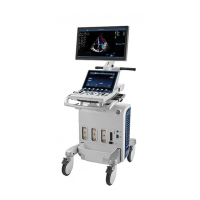Measurements and Analysis
8-20 Vivid S70 / S60 – User Manual
BC092760-1EN
01
Acquisition
Create an exam, connect the ECG device and make sure to
obtain a stable ECG trace.
Sequental acquistion
Acquire 2D grey scale cineloops of an APLAX, A4CH and A2CH
view.
NOTE: It is recommended to acquire all three apical views sequentially
to get similar heart rate in all views.
Acquisition requirements
• The frame rate should be exceeding 40 frames per second.
A higher frame rate is recommended for high heart rate.
• Heart rate variability between the recordings should not be
greater than 30%.
• The system should be configured to store 100 ms before
and after each heart cycle.
• If the acquisition has more than one heart cycle, the
analysis will by default be done on the second to last heart
cycle.
• The entire myocardium should be visible.
• A depth range that includes the entire left ventricle should
be used.
Starting AFI from sequential acquisition
1. Open the exam for which you want to perform AFI analysis
and select one of the apical images you would like to use for
the analysis.
2. Press Measure on the Control panel and select the AFI
study. The tool will launch and start up in the Select View
stage. (see Figure 8-11).
Annotate the view by clicking one of the view labeling buttons
(A4CH, A2CH, APLAX).
AFI is only recommended for adult cardiac images acquired
with the following probes: M5Sc-D, 3Sc-RS, 6Tc-RS or 6VT-D.
AFI is only recommended for pediatric cardiac images acquired
with the following probes: M5Sc-D, 3Sc-RS or 6S-D. The
measurement accuracies of the longitudinal strain values
reported in the Reference manual are verified with these
probes.

